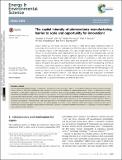| dc.contributor.author | Powell, Douglas M. | |
| dc.contributor.author | Fu, Ran | |
| dc.contributor.author | Horowitz, Kelsey | |
| dc.contributor.author | Basore, Paul A. | |
| dc.contributor.author | Woodhouse, Michael | |
| dc.contributor.author | Buonassisi, Tonio | |
| dc.date.accessioned | 2016-03-30T13:42:58Z | |
| dc.date.available | 2016-03-30T13:42:58Z | |
| dc.date.issued | 2015-09 | |
| dc.date.submitted | 2015-05 | |
| dc.identifier.issn | 1754-5692 | |
| dc.identifier.issn | 1754-5706 | |
| dc.identifier.uri | http://hdl.handle.net/1721.1/101914 | |
| dc.description.abstract | Using a bottom-up cost model, we assess the impact of initial factory capital expenditure (capex) on photovoltaic (PV) module minimum sustainable price (MSP) and industry-wide trends. We find capex to have two important impacts on PV manufacturing. First, capex strongly influences the per-unit MSP of a c-Si module: we calculate that the capex-related elements sum to 22% of MSP for an integrated wafer, cell, and module manufacturer. This fraction provides a significant opportunity to reduce MSP toward the U.S. DOE SunShot module price target through capex innovation. Second, a combination of high capex and low margins leads to a poor financial rate of return, which limits the growth rate of PV module manufacturing capacity. We quantify the capex of Czochralski-based crystalline silicon (c-Si) PV manufacturing, summing to 0.68 $/W[subscript aCap] ($ per annual production capacity in watts, $year/W) from wafer to module and 1.01 $/W[subscript aCap] from polysilicon to module. At a sustainable operating margin determined by the MSP methodology for our bottom-up scenario, we calculate the sustainable growth rate of PV manufacturing capacity to be ∼19% annually – below the historical trend of ∼50% annually. We conclude with a discussion of innovation opportunities to reduce the capex of PV manufacturing through both incremental and disruptive process innovation with c-Si, platform innovations, and financial approaches. | en_US |
| dc.description.sponsorship | National Science Foundation (U.S.) (NSF CA EEC-1041895) | en_US |
| dc.description.sponsorship | United States. Dept. of Energy | en_US |
| dc.language.iso | en_US | |
| dc.publisher | Royal Society of Chemistry | en_US |
| dc.relation.isversionof | http://dx.doi.org/10.1039/C5EE01509J | en_US |
| dc.rights | Creative Commons Attribution 3.0 Unported licence | en_US |
| dc.rights.uri | http://creativecommons.org/licenses/by/3.0/ | en_US |
| dc.source | Royal Society of Chemistry | en_US |
| dc.title | The capital intensity of photovoltaics manufacturing: barrier to scale and opportunity for innovation | en_US |
| dc.type | Article | en_US |
| dc.identifier.citation | Powell, Douglas M., Ran Fu, Kelsey Horowitz, Paul A. Basore, Michael Woodhouse, and Tonio Buonassisi. “The Capital Intensity of Photovoltaics Manufacturing: Barrier to Scale and Opportunity for Innovation.” Energy Environ. Sci. 8, no. 12 (2015): 3395–3408. © 2015 Royal Society of Chemistry | en_US |
| dc.contributor.department | Massachusetts Institute of Technology. Department of Mechanical Engineering | en_US |
| dc.contributor.mitauthor | Powell, Douglas M. | en_US |
| dc.contributor.mitauthor | Buonassisi, Tonio | en_US |
| dc.relation.journal | Energy & Environmental Science | en_US |
| dc.eprint.version | Final published version | en_US |
| dc.type.uri | http://purl.org/eprint/type/JournalArticle | en_US |
| eprint.status | http://purl.org/eprint/status/PeerReviewed | en_US |
| dspace.orderedauthors | Powell, Douglas M.; Fu, Ran; Horowitz, Kelsey; Basore, Paul A.; Woodhouse, Michael; Buonassisi, Tonio | en_US |
| dc.identifier.orcid | https://orcid.org/0000-0001-8345-4937 | |
| mit.license | PUBLISHER_CC | en_US |
| mit.metadata.status | Complete | |
